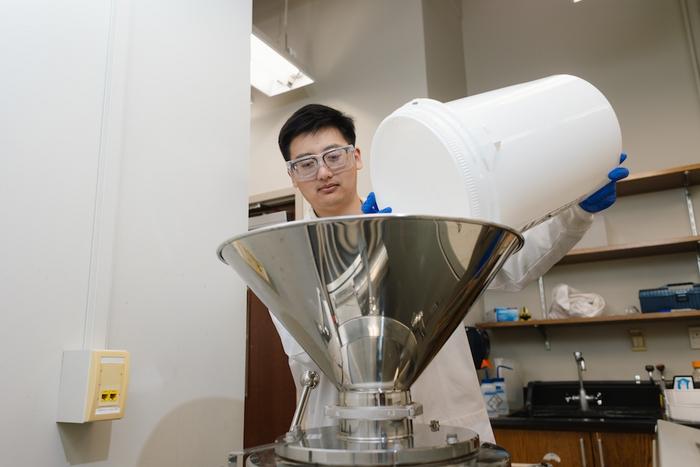
Research at the University of Tennessee is embarking on an ambitious journey that seeks to revolutionize the way we think about wood waste. The innovative project aims to transform scrap wood, often relegated to landfills, into a robust, metal-like alternative that could significantly reduce our reliance on traditional metals for structural applications. Led by Art Ragauskas, a prominent figure in biorefining and the acting department head of the Department of Chemical and Biomolecular Engineering, the project not only tackles waste management but also addresses sustainability concerns inherent in metal production.
The project, entitled “Waste Upcycling for Defense” (WUD), is noteworthy as it has secured a $2 million contract from the Defense Advanced Research Projects Agency (DARPA). This collaboration is a strategic move, as DARPA is renowned for pioneering advanced technologies with implications for national security. The University of Tennessee is not navigating this path alone; it is partnering with esteemed institutions such as the University of California, Riverside, and Georgia Tech, creating a robust network of research expertise aimed at tackling this monumental challenge.
At the heart of Ragauskas’s research lies the transformative potential of wood. Often dismissed as inferior when compared to steel and other alloys, wood possesses unique properties that can be harnessed with the right processing. By understanding the composition of wood, researchers have found that by removing lignin—the natural glue that binds wood cells together—wood can be rendered incredibly strong. The densification process, wherein wood is compressed after lignin removal, significantly enhances its strength and suitability as a material for a broader range of applications.
During the densification process, the cell walls of wood remain intact but are transformed at a molecular level. The removal of lignin creates spaces within the wood that, when compressed, allow the cellulose fibers to bond more effectively. Yunxuan Wang, a post-doctoral researcher on the team, explains that this results in an ultra-strong product that can rival the mechanical properties of metals. This transformation of waste wood into a high-performance material is groundbreaking, especially in a world where resource efficiency and environmental sustainability are becoming increasingly critical.
However, the project faces challenges, particularly when dealing with mixed waste wood materials, such as those derived from construction sites, furniture manufacturing, and landscaping. The diverse nature of these biosources can complicate the production process. Wang points out the difficulty of sourcing large, uniform chunks of wood; instead, much of what is available is often imperfect and fragmented, comprising sawdust and other byproducts. Therefore, the goal of the project is to maximize the utility of these lesser-quality materials, transforming them into high-strength densified boards without sacrificing performance.
The environmental implications of this research are significant. With an increasing awareness of the energy-intensive processes involved in metal production, there is an urgent need for alternative materials that minimize ecological footprints. The potential for strong wood composites to be utilized in various sectors, including automotive, aerospace, and construction, underlines the importance of this study. Historically, densified wood has found applications in high-stakes arenas, such as military aircraft during World War II, suggesting a rich legacy that could be revived in contemporary contexts.
As Ragauskas emphasizes, “The conversion of waste wood to a high-performance board provides a unique opportunity to turn ‘trash to cash.’” This approach has the potential to minimize landfill use while also addressing the logistical challenges associated with material sourcing for construction and manufacturing, especially in remote areas where traditional supply chains may falter.
The research aligns perfectly with global initiatives aimed at promoting sustainability and reducing material waste across industries. As the demand for sustainable building materials increases, findings from the University of Tennessee project could pave the way for new standards in material science. The application of high-strength wood composites could redefine traditional manufacturing paradigms, prompting industries to reconsider their material choices.
Despite the promising prospects, the journey ahead is fraught with uncertainties. Mistakes in processing or changes in material sourcing could derail efforts, but the collective expertise of the research team and their partnerships positions them well to navigate these obstacles. The collaboration not only provides a wealth of knowledge but also enhances the complexity of the research, allowing for a multidimensional approach to solving the problems associated with wood waste.
Furthermore, the projects’ implications extend beyond mere technical advancements; they also resonate deeply within the socio-economic context. The bridging of the gap between waste generation and high-performance material production aligns with global sustainability goals, providing economic opportunities while also addressing environmental concerns. Such innovations could lead to new industries centered around waste upcycling, thus generating jobs in regions where unemployment has been a persistent issue.
As we look ahead to a future where resource scarcity and environmental awareness shape our material choices, the University of Tennessee’s WUD project could serve as a beacon of hope. Transforming what was once considered waste into valuable material underscores a necessary paradigm shift in how we approach material science and environmental conservation. This pioneering research not only speaks to the technical advancements in wood processing but also highlights an ethic of stewardship toward the planet.
In summary, the project at the University of Tennessee promises groundbreaking advancements in turning wood waste into a viable metal alternative, with implications for various industries and the environment. As researchers delve deeper into the intricacies of wood densification and alternative applications, the hope is that this transformative approach will inspire similar initiatives worldwide.
Subject of Research: Conversion of wood waste into a high-performance metal alternative
Article Title: University of Tennessee Explores Transformative Wood Waste Research
News Publication Date: October 2023
Web References:
References:
Image Credits: University of Tennessee
Keywords
Tags: advanced materials for national securitybiorefining technologyDefense Advanced Research Projects Agencyenvironmental sustainability in engineeringinnovative metal alternativesstructural applications of woodsustainable materials researchtransforming scrap wood into resourcesuniversity research collaborationswaste management solutionswood as a structural materialwood waste upcycling





